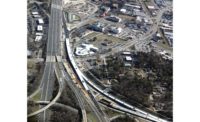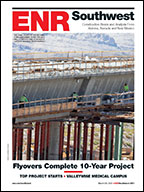Highways and bridges are major winners under House Democrats’ economic stimulus proposal, garnering $30 billion, the largest sum for any single public-works sector in the $825-billion package.
If the $30 billion holds through further congressional action, it would represent about a 75% bonus on top of the $41-billion federal highway obligation ceiling for all of 2008. John Horsley, American Association of State Highway and Transportation Officials’ executive director, says, “We of course have the capability to do more [than $30 billion], but that’s a very healthy boost to highway investment and we’re very pleased.”
Lawmakers also provided a further sweetener, waiving the usual 20% state matching-fund requirement.
Eric Keen, an executive vice president with Omaha-based HDR, says the stimulus allocation for highways “is a good amount of funds that will help revitalize the transportation industry.” But he adds, “We need to develop a long-term investment plan that goes well beyond this economic-stimulus plan.”

Largest program allocation in plan, but the Senate may propose a still-higher funding level.
“We appreciate the level of transportation investment as a whole” in the stimulus,” says Peter Ruane, CEO of the American Road & Transportation Builders Association. But he adds, “We obviously were expecting a larger number for highways in particular and anticipate that the Senate will make a run at increasing that number.”
The plan’s drafters didn’t include earmarks specifying funds for individual projects. Instead, most of the road aid will be distributed to states and localities by existing formulas.
However, there are some wrinkles in how the money is allotted. Of the $30 billion, a total of $590 million would be set aside for roads on Indian res-ervations or in national parks, technology training and bonding assistance for disadvantaged businesses. Another “takedown” of up to 0.5%, or $147 million, would go for management and oversight of the highway stimulus program.
That leaves about $29.3 billion, which would be parceled out by formulas. But there are twists there, too. AASHTO’s Horsley says 45% of the $29.3 billion, or about $13.2 billion, would be distributed under the existing Surface Transportation Program (STP). Following current STP requirements, 10% of the $13.2 billion, or about $1.3 billion, would be set aside for transportation “enhancements,” which include such projects as bicycle paths.
| PROJECT NAME | STATE | PROJECT TYPE | COST ($ MIL.) |
|---|---|---|---|
| State Route-22/Interstate-405 HOV Connector | Calif. | Paving | 200 |
| Route 7 Whittpenn Bridge Improvements CONTRACT 4 | N.J. | Bridge | 185 |
| Route 82 Bypass | Miss. | Paving | 80 |
| Nimmo Parkway Phase V | Va. | Paving | 61.7 |
| SOURCE: MCGRAW-HILL CONSTRUCTION DODGE, *PROJECTS CONSIDERED ELIGIBLE FOR STIMULUS FUNDING | |||
Also under STP, Horsley says there is a mandatory “suballocation” to metropolitan-area planning organizations, which would determine whether a state, city or county is best suited to manage a particular project. That suballocation amounts to 24% of the $29.3 billion total, or about $7 billion, AASHTO calculates.
Legislators attached other strings to the money. There is a “use it or lose it” requirement to ensure the funds go to projects that can begin quickly. States or other grantees will have 120 days after the Federal Highway Administration apportions the highway stimulus funds to get under contract 50% of the dollars allocated. They also would have until Aug. 1, 2010, to obligate the remaining money. That gives states “a little bit more leeway” for the second 50%, Horsley says. But if states don’t meet the deadlines, unused funds would be redistributed.
House Transportation and Infrastructure Committee Chairman James Oberstar (D-Minn.) says states and other infrastructure-aid recipients will have a “maintenance of effort” requirement to prove that they aren’t just substituting the new stimulus dollars for other funds.
Horsley says states will be alerting construction companies to “Get ready, because we’re going to have a surge of activity.” ARTBA’s Ruane says, “The capacity’s there...I’m very confident we’re going to meet that test.





Post a comment to this article
Report Abusive Comment